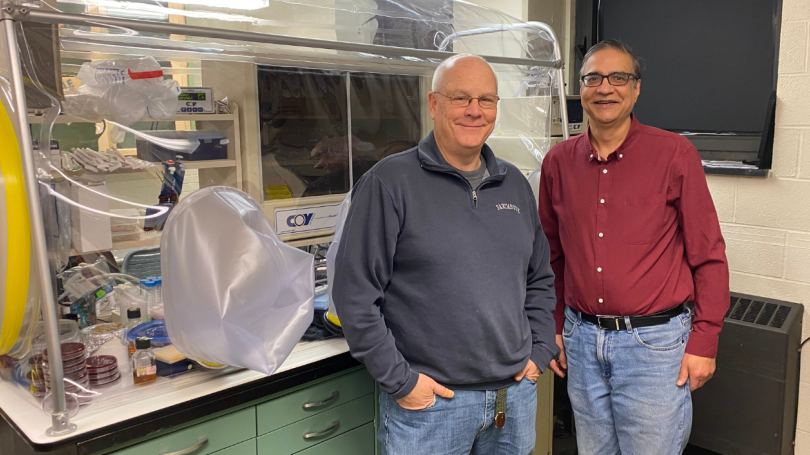
- About
- Education
- Research
- Engagement & Collaboration
- News & Events
Back to Top Nav
Back to Top Nav
Back to Top Nav
Back to Top Nav
Two Dartmouth faculty members have been awarded a $100,000 pilot grant to deepen our understanding of the role of marine microbes in carbon sequestration.
Professors Mukul Sharma from the Department of Earth Sciences, and George O'Toole, the Elmer R. Pfefferkorn, Ph.D. Professor of Microbiology and Immunology from the Geisel School of Medicine, were chosen for the grant, which is intended to foster innovative projects that promote cross-department collaboration at the intersection of energy, climate, and health.
The grant is supported by Dartmouth's Arthur L. Irving Institute for Energy and Society in collaboration with the Geisel School of Medicine's Department of Microbiology and Immunology.
In their project—Genetic Basis of Aggregate Formation in Marine Microbes: Understanding Mechanisms of CO2 Sequestration— Sharma and O'Toole will explore mutant microbes that are unable to enhance carbon dioxide sequestration. By studying these mutants, they aim to uncover the mechanisms that enable normal microbes to facilitate carbon capture effectively. This foundational research will inform subsequent studies on priming the marine biological pump to further enhance marine carbon sequestration.
The marine biological pump plays a crucial role in regulating the Earth's climate by removing CO2 from the atmosphere and storing it in the deep ocean. Phytoplankton, a type of marine microbe, initiates this process through photosynthesis, converting sunlight, water, and CO2 into organic carbon compounds. This process sequesters 80-146 Petagrams (Pg, a billion metric tons) of atmospheric CO2 annually. However, over 90% of this captured carbon is re-released as CO2 back into the atmosphere due to oxidation by marine biota.
For context, to effectively mitigate climate change and limit global warming to around 1.5 degrees Celsius, studies suggest it may be necessary to remove about 1-2 Pg of CO2 from the atmosphere annually. Tens to hundreds of Pg of CO2 may need to be removed from the atmosphere over the coming decades for significant climate stabilization according to the IPCC's Sixth Assessment Report.
In previous studies, Professors Sharma and O'Toole demonstrated that broadcasting clay dust over the ocean surface initiates a pathway that potentially enhances marine biological pumping of atmospheric CO2 to depth.
"Many marine heterotrophic bacteria stick to clay minerals by producing glue-like polymers, which also entangle and entrain ambient phytoplankton, creating rapidly sinking clay-carbon bearing blobs," says Sharma. "These blobs are subsequently ingested by zooplankton that egest fast-sinking fecal pellets potentially 100s of meters deep below the sea surface."
Early findings suggest that clay broadcasting over sea surface could substantially increase the amount CO2 safely sequestered in the ocean depths.
"The work and the funding mechanism is an example of the type of cross-disciplinary, collaborative, program-building studies that is the best of science at Dartmouth. It's great to see researchers from across the institution come together to do society-impacting work," says O'Toole.
By elucidating the mechanisms through which microbes produce particles that facilitate the sinking of fecal matter into the ocean depths, the researchers hope to develop advanced methods to optimize natural processes that enhance biological carbon sequestration, potentially sequestering on the order of a Pg of CO2 annually.
Near-term objectives include compiling a publishable dataset and generating key preliminary data to advance further focused studies.